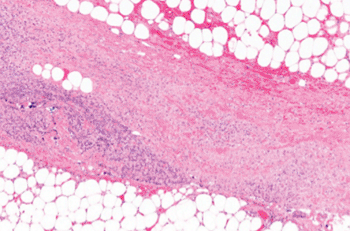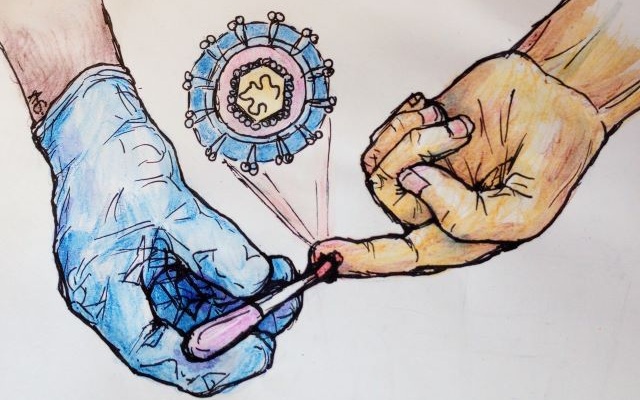Asparagine Metabolism Empowers Group A Streptococcus Infection
|
By LabMedica International staff writers Posted on 30 Jan 2014 |
![Image: Photomicrograph (900x) of Streptococcus pyogenes bacteria, viewed using Pappenheim\'s stain (Photo courtesy of the CDC - [US] Centers for Disease Control and Prevention). Image: Photomicrograph (900x) of Streptococcus pyogenes bacteria, viewed using Pappenheim\'s stain (Photo courtesy of the CDC - [US] Centers for Disease Control and Prevention).](https://globetechcdn.com/mobile_labmedica/images/stories/articles/article_images/2014-01-30/GMS-020a.gif)
Image: Photomicrograph (900x) of Streptococcus pyogenes bacteria, viewed using Pappenheim\'s stain (Photo courtesy of the CDC - [US] Centers for Disease Control and Prevention).

Image: Micrograph (H&E stain) of necrotizing fasciitis, showing necrosis (center of image) of the dense connective tissue, i.e., fascia, interposed between fat lobules (top-right and bottom-left of image) (Photo courtesy of Wikimedia Commons).
The bacteria that cause the frightening syndrome called "flesh-eating disease" have been found to be stimulated by the amino acid asparagine and inhibited by the chemotherapeutic enzyme asparaginase, which destroys asparagine.
Necrotizing fasciitis or NF, commonly known as "flesh-eating disease" is a rare infection of the deeper layers of skin and subcutaneous tissues, which quickly spreads across the fascial plane within the subcutaneous tissue. Individuals having compromised immune systems (due to conditions like diabetes, cancer, etc.) have greater risk of developing NF. It is a severe disease of sudden onset and is usually treated immediately with high doses of intravenous antibiotics. "Flesh-eating disease" is a misnomer, as the bacteria involved—most frequently Streptococcus pyogenes, or Group A Streptococcus (GAS)—do not actually "eat" the tissue. They cause the destruction of skin and muscle by releasing toxins, which include streptococcal pyogenic exotoxins.
Investigators at the Hebrew University of Jerusalem (Israel) reported in the January 16, 2014, issue of the journal Cell that during adherence to host cells, GAS releases streptolysin toxins, which create endoplasmic reticulum stress in the host cells. This stress causes an increase in the expression of the enzyme asparagine synthetase and the production of asparagine. The released asparagine is sensed by the bacteria, which induces altered expression of about 17% of the bacterial genes.
Asparaginase, a widely used chemotherapeutic agent, was found to block GAS growth in human blood and prevented GAS proliferation in a mouse model. To date asparaginase has not been used to treat GAS infections.
The Yissum Research Development Company (Jerusalem, Israel), the technology transfer arm of the Hebrew University of Jerusalem, has registered a patent for this discovery and is seeking commercial partners to help develop effective therapies against invasive Streptococcus infections.
Related Links:
Hebrew University of Jerusalem
Yissum Research Development Company
Necrotizing fasciitis or NF, commonly known as "flesh-eating disease" is a rare infection of the deeper layers of skin and subcutaneous tissues, which quickly spreads across the fascial plane within the subcutaneous tissue. Individuals having compromised immune systems (due to conditions like diabetes, cancer, etc.) have greater risk of developing NF. It is a severe disease of sudden onset and is usually treated immediately with high doses of intravenous antibiotics. "Flesh-eating disease" is a misnomer, as the bacteria involved—most frequently Streptococcus pyogenes, or Group A Streptococcus (GAS)—do not actually "eat" the tissue. They cause the destruction of skin and muscle by releasing toxins, which include streptococcal pyogenic exotoxins.
Investigators at the Hebrew University of Jerusalem (Israel) reported in the January 16, 2014, issue of the journal Cell that during adherence to host cells, GAS releases streptolysin toxins, which create endoplasmic reticulum stress in the host cells. This stress causes an increase in the expression of the enzyme asparagine synthetase and the production of asparagine. The released asparagine is sensed by the bacteria, which induces altered expression of about 17% of the bacterial genes.
Asparaginase, a widely used chemotherapeutic agent, was found to block GAS growth in human blood and prevented GAS proliferation in a mouse model. To date asparaginase has not been used to treat GAS infections.
The Yissum Research Development Company (Jerusalem, Israel), the technology transfer arm of the Hebrew University of Jerusalem, has registered a patent for this discovery and is seeking commercial partners to help develop effective therapies against invasive Streptococcus infections.
Related Links:
Hebrew University of Jerusalem
Yissum Research Development Company
Latest BioResearch News
- Genome Analysis Predicts Likelihood of Neurodisability in Oxygen-Deprived Newborns
- Gene Panel Predicts Disease Progession for Patients with B-cell Lymphoma
- New Method Simplifies Preparation of Tumor Genomic DNA Libraries
- New Tool Developed for Diagnosis of Chronic HBV Infection
- Panel of Genetic Loci Accurately Predicts Risk of Developing Gout
- Disrupted TGFB Signaling Linked to Increased Cancer-Related Bacteria
- Gene Fusion Protein Proposed as Prostate Cancer Biomarker
- NIV Test to Diagnose and Monitor Vascular Complications in Diabetes
- Semen Exosome MicroRNA Proves Biomarker for Prostate Cancer
- Genetic Loci Link Plasma Lipid Levels to CVD Risk
- Newly Identified Gene Network Aids in Early Diagnosis of Autism Spectrum Disorder
- Link Confirmed between Living in Poverty and Developing Diseases
- Genomic Study Identifies Kidney Disease Loci in Type I Diabetes Patients
- Liquid Biopsy More Effective for Analyzing Tumor Drug Resistance Mutations
- New Liquid Biopsy Assay Reveals Host-Pathogen Interactions
- Method Developed for Enriching Trophoblast Population in Samples
Channels
Clinical Chemistry
view channel
Blood Test Could Predict and Identify Early Relapses in Myeloma Patients
Multiple myeloma is an incurable cancer of the bone marrow, and while many patients now live for more than a decade after diagnosis, a significant proportion relapse much earlier with poor outcomes.... Read more
Compact Raman Imaging System Detects Subtle Tumor Signals
Accurate cancer diagnosis often depends on labor-intensive tissue staining and expert pathological review, which can delay results and limit access to rapid screening. These conventional methods also make... Read moreMolecular Diagnostics
view channel
Ultra-Sensitive Blood Biomarkers Enable Population-Scale Insights into Alzheimer’s Pathology
Accurately estimating how many people carry Alzheimer’s disease pathology has long been a challenge, as traditional methods rely on small, clinic-based samples rather than the general population.... Read more
Blood Test Could Predict Death Risk in World’s Most Common Inherited Heart Disease
Hypertrophic cardiomyopathy (HCM) is the world’s most common inherited heart condition and affects millions of people globally. While some patients live with few or no symptoms, others develop heart failure,... Read moreHematology
view channel
MRD Tests Could Predict Survival in Leukemia Patients
Acute myeloid leukemia is an aggressive blood cancer that disrupts normal blood cell production and often relapses even after intensive treatment. Clinicians currently lack early, reliable markers to predict... Read more
Platelet Activity Blood Test in Middle Age Could Identify Early Alzheimer’s Risk
Early detection of Alzheimer’s disease remains one of the biggest unmet needs in neurology, particularly because the biological changes underlying the disorder begin decades before memory symptoms appear.... Read more
Microvesicles Measurement Could Detect Vascular Injury in Sickle Cell Disease Patients
Assessing disease severity in sickle cell disease (SCD) remains challenging, especially when trying to predict hemolysis, vascular injury, and risk of complications such as vaso-occlusive crises.... Read more
ADLM’s New Coagulation Testing Guidance to Improve Care for Patients on Blood Thinners
Direct oral anticoagulants (DOACs) are one of the most common types of blood thinners. Patients take them to prevent a host of complications that could arise from blood clotting, including stroke, deep... Read moreImmunology
view channel
Ultrasensitive Liquid Biopsy Demonstrates Efficacy in Predicting Immunotherapy Response
Immunotherapy has transformed cancer treatment, but only a small proportion of patients experience lasting benefit, with response rates often remaining between 10% and 20%. Clinicians currently lack reliable... Read more
Blood Test Could Identify Colon Cancer Patients to Benefit from NSAIDs
Colon cancer remains a major cause of cancer-related illness, with many patients facing relapse even after surgery and chemotherapy. Up to 40% of people with stage III disease experience recurrence, highlighting... Read moreMicrobiology
view channel
New UTI Diagnosis Method Delivers Antibiotic Resistance Results 24 Hours Earlier
Urinary tract infections affect around 152 million people every year, making them one of the most common bacterial infections worldwide. In routine medical practice, diagnosis often relies on rapid urine... Read more
Breakthroughs in Microbial Analysis to Enhance Disease Prediction
Microorganisms shape human health, ecosystems, and the planet’s climate, yet identifying them and understanding how they are related remains a major scientific challenge. Even with modern DNA sequencing,... Read morePathology
view channel
Genetics and AI Improve Diagnosis of Aortic Stenosis
Aortic stenosis is a progressive narrowing of the aortic valve that restricts blood flow from the heart and can be fatal if left untreated. There are currently no medical therapies that can prevent or... Read more
AI Tool Simultaneously Identifies Genetic Mutations and Disease Type
Interpreting genetic test results remains a major challenge in modern medicine, particularly for rare and complex diseases. While existing tools can indicate whether a genetic mutation is harmful, they... Read more
Rapid Low-Cost Tests Can Prevent Child Deaths from Contaminated Medicinal Syrups
Medicinal syrups contaminated with toxic chemicals have caused the deaths of hundreds of children worldwide, exposing a critical gap in how these products are tested before reaching patients.... Read more
Tumor Signals in Saliva and Blood Enable Non-Invasive Monitoring of Head and Neck Cancer
Head and neck cancers are among the most aggressive malignancies worldwide, with nearly 900,000 new cases diagnosed each year. Monitoring these cancers for recurrence or relapse typically relies on tissue... Read moreTechnology
view channel
Pioneering Blood Test Detects Lung Cancer Using Infrared Imaging
Detecting cancer early and tracking how it responds to treatment remains a major challenge, particularly when cancer cells are present in extremely low numbers in the bloodstream. Circulating tumor cells... Read more
AI Predicts Colorectal Cancer Survival Using Clinical and Molecular Features
Colorectal cancer is one of the most common and deadly cancers worldwide, and accurately predicting patient survival remains a major clinical challenge. Traditional prognostic tools often rely on either... Read moreIndustry
view channel
BD and Penn Institute Collaborate to Advance Immunotherapy through Flow Cytometry
BD (Becton, Dickinson and Company, Franklin Lakes, NJ, USA) has entered into a strategic collaboration with the Institute for Immunology and Immune Health (I3H, Philadelphia, PA, USA) at the University... Read more





















